
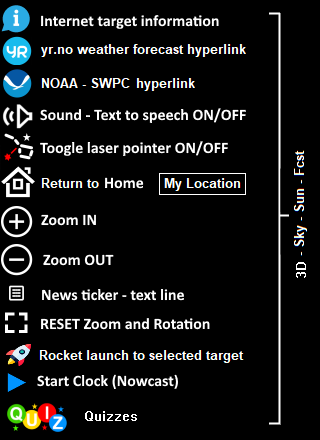
|
Thanks for installing Aurora Forecast Rocketeer.
As a result, from user feedback, this version is simplified with removed features such as satellite orbits,
sounding rocket trajectories and advanced options that are available in the original app named Aurora Forecast 3D.
The aim is to provide an easy-to-use app with focus on auroral forecasting.
Note that the original app will still be available and updated.
Hopefully, you will enjoy it and make use of it as a tool to track down the aurora. It renders the Earth in 3D with rotation and scaling at your fingertips. The Sun illuminates the globe as it updates in near real-time (1s). The forecasts are up to 3 days ahead in time. They are updated when the app is active and connected to internet. The Sky module shows a fish-eye view of the sky including the auroral ovals, planets and stars as seen from any ground point location.
Below is a description on how to use the app.
|

|
The above screen shot is marked with text labels.
The circular green/red transparent belt is the aurora oval produced by solar wind electrons.
The red colored part of the oval represents the dayside Cusp aurora.
Two colored polygons mark the positions of My Location (red) and the Ground-track point (orange).
The optical horizon for 110 km of altitude is visualized as a transparent disk centered at the track point.
City lights are included based on data from the NASA/Goddard Space Flight Center.[1] In addition, an aurora compass is shown in the top left corner and 7 x speed buttons are grouped to the right. The auroral activity is presented using a speedometer layout. |
|
One semi-empirical aurora oval model is used in the app.
The model [2] is named Starkov (1994) and is based on ground-based all-sky camera data obtain from
Soviet Union ice drift stations during the International Geophysical Year back in 1958.
The ovals are visualized [3] using green to red colored polygon overlays.
|
 |
The Aurora Compass shows where the auroral oval is located as you look up
at the sky from the center Ground-track point.
|
|
This point is marked with an orange circular polygon on the Globe.
The latitude and longitude are shown at the top of the screen.
You can rotate the Globe to move to any desired position.
The oval all-sky cover is shown in percentage in the center of the compass. The orange star marks the position of the Sun in the compass. The Moon symbol is explained below according to phase and age. These will only appear if they are within the field of view as seen from the Ground-track point. |

|
The above symbols represent the Moon as observed from the northern hemisphere.
In the southern hemisphere these moon symbols are swapped horizontally (mirrored).
|
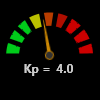 |
The speedometer is used to visualize the auroral
activity based on the Kp index (0 - 9).
|
|
The index is a measure on how disturbed the planetary
geomagnetic field is. It is directly related to auroral activity.
The predicted Kp values (upto 3 days ahead) are estimated by the
Space Weather Prediction Centre (NOAA-SWPC) using satellites
that monitor the Sun.
Hint: You can set your own Kp index by tapping the color scale on the wheel. |


|
The positions [4] and apparent size of the inner planets are scaled in 3D
according to the size of the Earth, but the distance is for artistic reasons
not correct. It is in reality much further away. The apparent distance of the Sun is scaled down 500 times.
The outer planets are scaled down and located at infinity close to the stars.
Textures of the Earth, the Sun and the Moon are downloaded from the internet. [5,6]
|
|
The stars and constellations in the 3D viewport are from the Tycho catalog sky map by NASA [7] version 2.0.
The map is projected using a cylindrical-equidistant transform that is wrapped to an outer celestial sphere.
|
|
The red cross in the star map marks the position of Zero Right Ascension (RA) and Declination (DEC).
|
|
It is known as the First Point of Aries and is the location of the vernal equinox
|
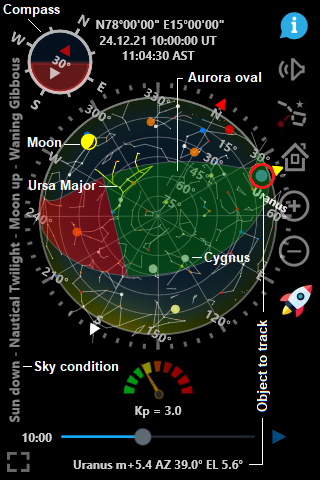
|
The Sky module is activated by tapping the Aurora Compass in the 3D viewport.
The Bright Star Catalogue edition 5 (BSC5) [8] is used to plot stars.
A yellow circle identifies the selected object to track in azimuth (AZ) and elevation (EL).
The constellation signs are adopted from the International Astronomical Union (IAU).[9]
Note that the aurora is only visible to the human eye when the sun elevation is more than 10 degrees below the horizon. |
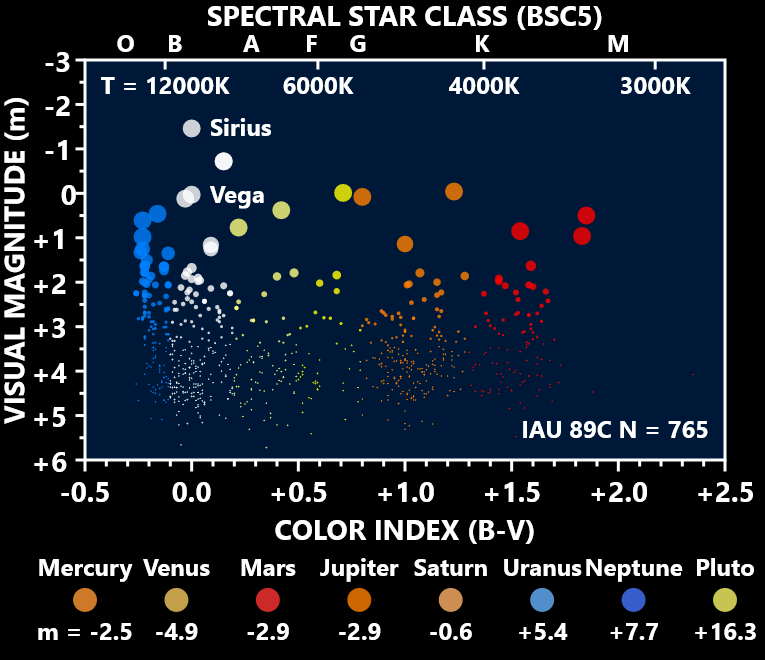
|
The stars and planets are color coded. The above shows the Hertzsprung - Russel diagram used.
Stars are plotted as a function of the B-V color index and the apparent magnitude (m).
It visualizes the relationship between a star's luminosity as seen from Earth
and its stellar classification or blackbody temperature (T).
|
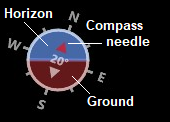 |
The compass rose shows the azimuth angle orientation of the Sky on your device. You may use it to navigate.
|
|
First, identify a known object in the sky.
Secondly, mark it in the Sky viewport and level the computer screen horizontally.
Then rotate the Sky to align the yellow arrow towards the objects viewing direction.
The compass should as a result show True North.
The accuracy mainly depends on correct time on your device and pointing direction. Your current location should also be updated as frequent as possible using known wave points. |
 |
A powerful laser is fired up from the center of the Earth to any planet or star constellation.
|
|
Laser targets are selected by tapping on objects of interest in the 3D viewport.
All planets in the solar system and a total of 765 bright Stars and 89 constellation signs (asterisms) may be located and identified by the laser.
|
 |
Fly-by-rocket to selected targets like the Sun, the Moon, or any planet.
Use the My Location button to return to Earth home.
|
 |
Target information about star constellations, planets and location are launched as a shared activity
in your default web browser.
|
|
Star constellation and planetary information is obtained from Wikipedia.
Ground targets are identified by the use of the Nominatim search engine from the Open Street Map organization.
Note that it is only activated for the onclick handler of the Ground-track point in the 3D viewport at max Zoom IN (+).
A blue pin marks the selected target.
|
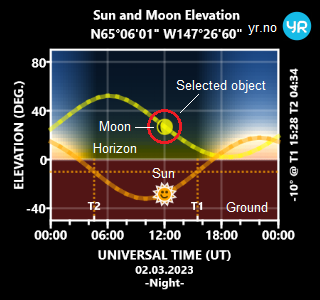
|
The Sun module shows the daily elevation plots for the Sun (orange) and the Moon (yellow).
You may click on each data point to view the actual numbers.
The set and rise times are calculated when the sun is -0.833
degrees below the horizon.
The background sky illuminance is calculated by the Perez formula.[10] Zenith and clear skylight distribution coefficients are from Preetham et al. (1999).[11] The local calculated global irradiance perpendicular to the sun’s rays at sea level is based on experimental work by Kasten and Young (1989) [12] and Meinel (1976).[13] The Yr.no hyperlink points to the weather forecast map service by YR which is served by the Norwegian Meteorological Institute (NMI) and the Norwegian Broadcasting Corporation (NRK). |
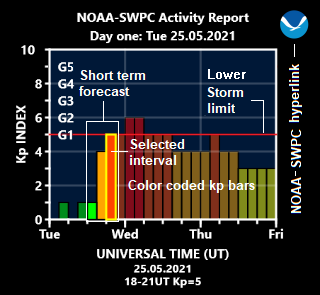
|
The FCST (ForeCaST) module summarizes the 3-day forecast from NOAA-SWPC.
Three hours wide color-coded bars are plotted as a function of time.
The lower minor storm limit at Kp = 5 is plotted as a red horizontal line.
The highlighted bars are the current short-term forecasts, accompanied by a seven line text summary.
You may click on each bar to view the effect in both the 3D viewport and in the Sky module.
Note that any aurora occurrence of the 3-day long term forecast depends highly on the solar wind IMF configuration, and might not kick in. |
|
NOAA-SWPC geomagnetic activity report is shown as a sliding text line- news ticker.
System news is also displayed here.
Click bottom left button to view any messages.
These messages use abbreviations.
|
| Scale |
Description
|
Kp
|
Frequency
|
| G1 |
Minor
|
5
|
1700
|
| G2 |
Moderate
|
6
|
600
|
| G3 |
Strong
|
7
|
200
|
| G4 |
Severe
|
8
|
100
|
| G5 |
Extreme
|
9
|
4
|
|
The frequency is number of events per solar cycle (11 years).
|
| Short |
Description
|
| AR |
Active sunspot Region
|
| AST |
Apparent Solar Time
|
| CGM |
Corrected Geo-Magnetic coordinates
|
| CH |
Coronal Hole
|
| CIR |
Co-rotating Interaction Region
|
| CME |
Coronal Mass Ejection
|
| DSF |
Disappearing Solar Filament
|
| FCST |
ForeCaST
|
| HP |
Hemispheric Power
|
| HSC |
Heliospheric Current Sheet
|
| HSS |
High Speed Stream
|
| IMF |
Interplanetary Magnetic Field
|
| L1 |
Lagrangian point 1
|
| LAT |
Latitude
|
| LON |
Longitude
|
| LOC |
Location
|
| LHA |
Local Hour Angle
|
| NP |
North Pole
|
| SI |
Sudden Impulse
|
| SIR |
Stream Interaction Region
|
| SP |
South Pole
|
| SPE |
Solar Proton Event
|
| SSBC |
Solar Sector Boundary Crossing
|
| UT |
Universal Time
|
|
First, locate a city or an airport above the Arctic Circle.
Secondly, remember that it has to be dark. The Sun needs to be ~10 degrees below the horizon.
Otherwise, the aurora will be drowned in solar light.
In the northern hemisphere, this means late autumn to early spring with best viewing conditions
during the late afternoon and into the night.
At Svalbard we see it all day during mid-winter.
Thirdly, I would recommend a location where there is stable cold in-land climate during the winter.
For example, Fairbanks in Alaska or Alta in Norway are excellent locations.
Another option is to take a boat trip and hunt for clear skies.
|
|
For most people on Earth, you will have time to eat dinner. Then check your local weather forecast for clear skies.
Start the app and locate the auroral oval. If you have a clear view of the oval above your head, seen in the Aurora Compass,
then you have up to 75% chance to see the aurora.
Happy hunting!
|
|
The app is setup to Nowcast and Forecast in Universal Time (UT).
The Apparent Solar Time (AST) is calculated using the Local Hour Angle (LHA) of the Sun.
As a consequence, AST depends on your location and may be crudely measured with a sundial.
|
|
Note that the app will still work if your device is not connected to the internet.
But the Kp index, the news-ticker and the internet target information are then not updated.
Default input values and locations can be restored.
Close the app and delete the directory named AuroraForecastR in your Documents folder.
You can now restart with default settings.
It also works without location permission, if the user denies the app access to the location sensor. |
|
The app is developed for the auroral research community as a tool to locate the theoretical position of the aurora
including stars and planetary positions from a local sky view perspective. The work started back in 2010 with the
first version available through the web for only six stations or predefined locations. In 2012 it was together with
the company Apex.no released under the name "Aurora Forecast" to work on Android, iPhone and Windows phones.
In order to overcome the spatial limitations and dependency on third parties, a new version has been developed using Embarcaderos cross platform Firemonkey compiler. As a result, with over 40k lines of source code in Pascal, the "Aurora Forecast 3D" app was released in August 2017. It is now available for Android, iOS, OSX, Windows and Linux operative systems. A positive spin off is the app's popularity within the aurora tourist industry and the radio-amateur community. |
|
[1] The Visible Earth catalog, visibleearth.nasa.gov, NASA/Goddard Space Flight Center, April-October, 2012.
|
|
[2] Starkov G. V., Mathematical model of the auroral boundaries,
Geomagnetism and Aeronomy, 34 (3), 331-336, 1994.
|
|
[3] Sigernes F., M. Dyrland, P. Brekke, S. Chernouss, D.A. Lorentzen, K. Oksavik, and C.S. Deehr,
Two methods to forecast auroral displays, Journal of Space Weather and Space Climate (SWSC),
Vol. 1, No. 1, A03, DOI:10.1051/swsc/2011003, 2011.
|
|
[4] P. Schlyter, How to compute planetary positions, stjarnhimlen.se, Stockholm, Sweden, 1979.
|
|
[5] T. Patterson, Natural Earth III - Texture Maps, www.shadedrelief.com, October 1, 2016.
|
|
[6] Nexus - Planet Textures, www.solarsystemscope.com, January 4, 2013.
|
|
[7] Bridgman, T. and Wright, E., The Tycho Catalog Sky map- Version 2.0, NASA/Goddard Space Flight
Center Scientific Visualization Studio, svs.gsfc.nasa.gov, January 26, 2009.
|
|
[8] Hoffleit, D. and Warren, Jr., W.H., The Bright Star Catalog, 5th Revised Edition (Preliminary Version),
Astronomical Data Center, NSSDC/ADC, 1991.
|
|
[9] Christensen L.L., M. Andre, B. Rino, R.Y. Shida, J. Enciso, G.M. Carillo, C. Martins, and M.R. D'Antonio,
The Constellations, The International Astronomical Union (IAU), iau.org, 2019.
|
|
[10]
Perez R., J.M. Seals, and P. Ineichen, An all-weather model for sky luminance distribution, Solar Energy, 1993.
|
|
[11]
Preetham A.J., P. Shirley and B. Smith, A practical analytic model for daylight, Computer Graphics, (SIGGRAPH '99 Proceedings), 91-100, 1999.
|
|
[12]
Kasten F. and A.T. Young, Revised optical air mass tables and approximation formula, Applied Optics, 28, 4735 - 4738, 1989.
|
|
[13]
Meinel A.B. and M.P. Meinel, Applied Solar Energy, Addision Wesley Publishing Co., 1976.
|
|
Acknowledgement
We wish to thank the National Oceanic and Atmospheric Administration (NOAA) - Space Weather Prediction Centre (SWPC) for allowing us to download the predicted value of the 3-day Kp index and the space weather textline forecast. The Text-to-Speech functionality is provided by the use of the excellent Grijjy, Inc. cross platform library. The Checklist module is based on Johan Åhlgren hardcoded quiz game source code. Sound effects are from my brother Ørnulf who stole my guitar and moved to Holland. |
|
Copyright
The application is made by F. Sigernes (email: freds@unis.no) (JW5JUA), Longyearbyen, Svalbard, Norway (2016). It is licensed as fredware. |
|
Disclaimer
This software is provided as it is with undiscovered bugs and errors. F. Sigernes and associates are not responsible for any negative consequences that could occur by the use if this application. |